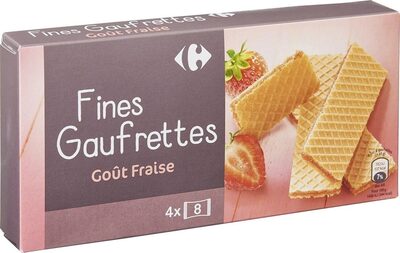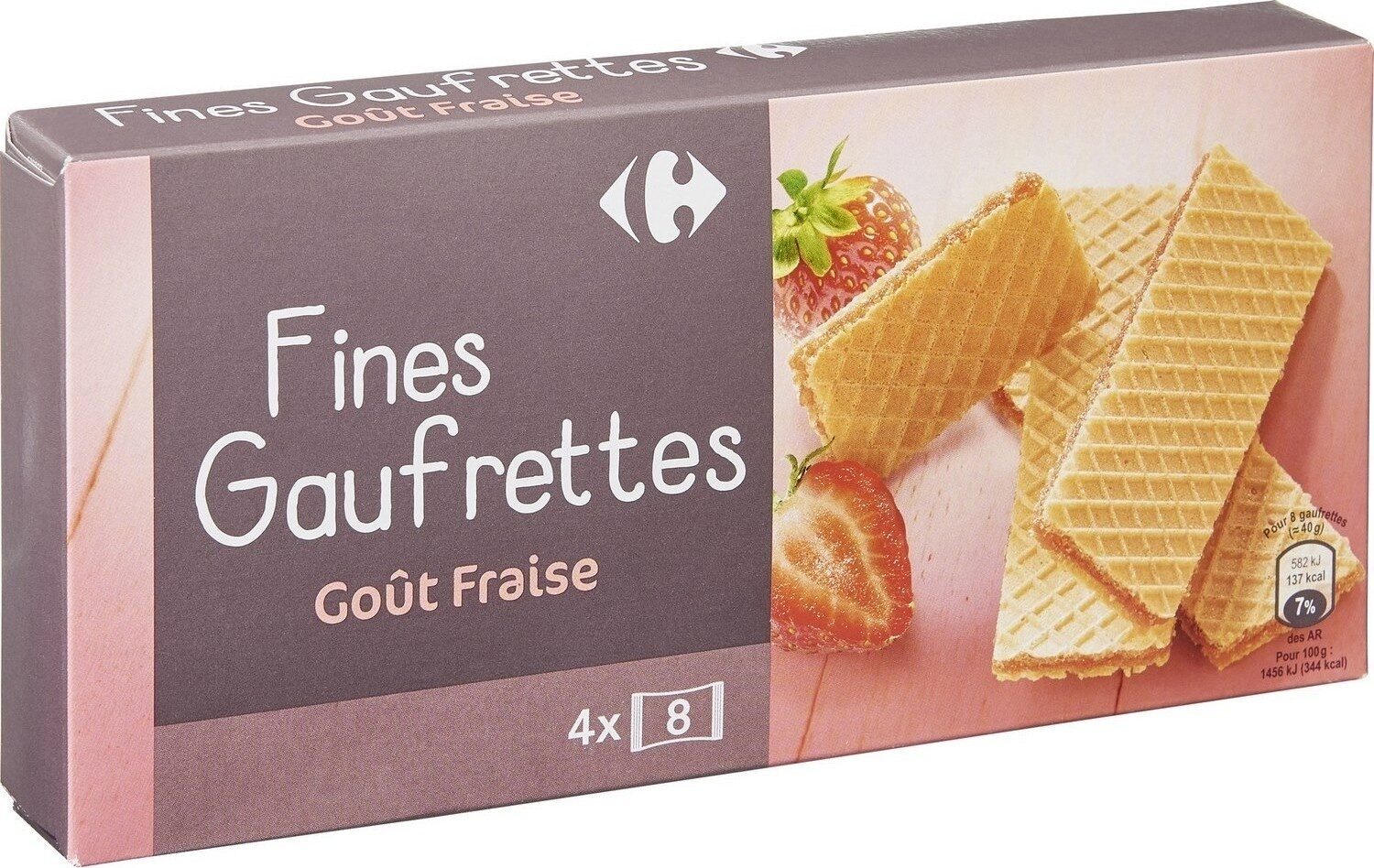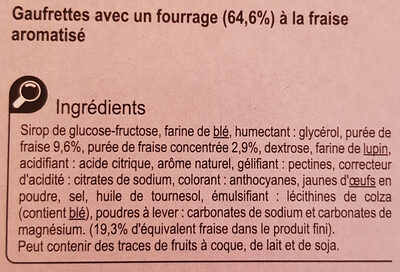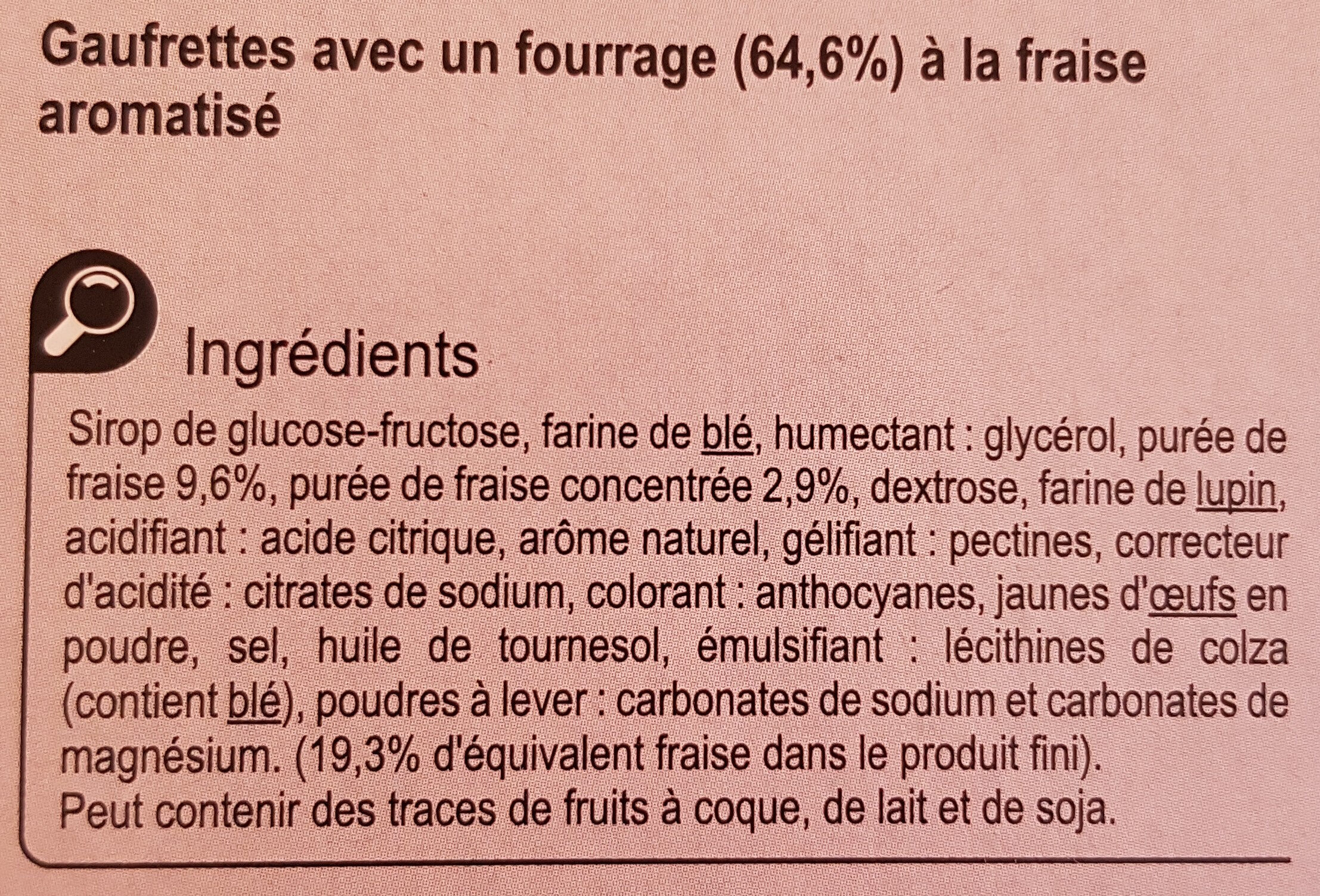Ajuda'ns a fer que la transparència alimentària sigui la norma!
Com a organització sense ànim de lucre, depenem de les vostres donacions per continuar informant els consumidors de tot el món sobre tot allò què mengen.
La revolució alimentària comença amb tu!
Fines gaufrettes goût fraise - Carrefour - 160 g
Fines gaufrettes goût fraise - Carrefour - 160 g
Aquesta pàgina del producte no està completa. Podeu ajudar a completar-la editant-la i afegint-hi més dades a partir de les fotos ja disponibles, o fent-ne més amb l'aplicació de androide o iPhone / iPad. Gràcies!
×
Algunes de les dades d’aquest producte les ha proporcionat directament el fabricant Carrefour.
Codi de barres: 3560071076849 (EAN / EAN-13)
Nom comú: Gaufrettes avec un Fourrage (64,6%) à la fraise aromatisé.
Quantitat: 160 g
Empaquetament: Cartó, fr:Sachet plastique
Marques: Carrefour
Categories: Snacks, Aperitius dolços, Galetes i pastissos, Galetes, en:Wafers, en:Stuffed wafers, en:Fruits stuffed wafers
Etiquetes, certificacions, premis: Fet a França
Origen del producte i / o dels seus ingredients: Ces gaufrettes sont fabriquées en France à partir de fraise récoltées en UE.
Origen dels ingredients: fr:Fraises : UE
Llocs de fabricació o processament: France
Codi de traçabilitat: EMB 29020H - Briec (Finistère, France)
Botigues: Carrefour, carrefour.fr
Matching with your preferences
Salut
Ingredients
-
25 ingredients
: Sirop de glucose-fructose, farine de blé, humectant : glycérol, purée de fraise 9,6%, purée de fraise concentrée 2,9%, dextrose, farine de lupin, acidifiant : acide citrique, arôme naturel, gélifiant : pectines, correcteur d'acidité : citrates de sodium, colorant : anthocyanes, jaunes d'œufs en poudre, sel, huile de tournesol, émulsifiant : lécithines de colza, poudres à lever : carbonates de sodium et carbonates de magnésium (*19,3% d'équivalent fraise dans le produit fini). Peut contenir des traces de fruits à coque, de lait et de soja.Al·lèrgens: en:Eggs, en:Gluten, en:LupinRastres: en:Milk, en:Nuts, en:Soybeans
Processament d'aliments
-
Aliments ultra processats
Elements que indiquen que el producte està al grup 4 - Aliments i begudes ultraprocessats:
- Additiu: E163 - Antocianines
- Additiu: E322 - Lecitines
- Additiu: E422 - Glicerol
- Additiu: E440 - Pectina
- Ingredient: Color
- Ingredient: Dextrosa
- Ingredient: Emulsionant
- Ingredient: Aromes
- Ingredient: Gelificant
- Ingredient: Glucosa
- Ingredient: Humectant
Els productes alimentaris es classifiquen en 4 grups segons el seu grau de processament:
- Aliments no processats o mínimament processats
- Ingredients culinaris processats
- Aliments processats
- Aliments ultra processats
La determinació del grup es fa en funció de la categoria del producte i dels ingredients que conté.
Additius
-
E163 - Antocianines
Anthocyanin: Anthocyanins -also anthocyans; from Greek: ἄνθος -anthos- "flower" and κυάνεος/κυανοῦς kyaneos/kyanous "dark blue"- are water-soluble vacuolar pigments that, depending on their pH, may appear red, purple, or blue. Food plants rich in anthocyanins include the blueberry, raspberry, black rice, and black soybean, among many others that are red, blue, purple, or black. Some of the colors of autumn leaves are derived from anthocyanins.Anthocyanins belong to a parent class of molecules called flavonoids synthesized via the phenylpropanoid pathway. They occur in all tissues of higher plants, including leaves, stems, roots, flowers, and fruits. Anthocyanins are derived from anthocyanidins by adding sugars. They are odorless and moderately astringent. Although approved to color foods and beverages in the European Union, anthocyanins are not approved for use as a food additive because they have not been verified as safe when used as food or supplement ingredients. There is no conclusive evidence anthocyanins have any effect on human biology or diseases.Origen: Wikipedia (Anglès)
-
E322 - Lecitines
Lecithin: Lecithin -UK: , US: , from the Greek lekithos, "egg yolk"- is a generic term to designate any group of yellow-brownish fatty substances occurring in animal and plant tissues, which are amphiphilic – they attract both water and fatty substances -and so are both hydrophilic and lipophilic-, and are used for smoothing food textures, dissolving powders -emulsifying-, homogenizing liquid mixtures, and repelling sticking materials.Lecithins are mixtures of glycerophospholipids including phosphatidylcholine, phosphatidylethanolamine, phosphatidylinositol, phosphatidylserine, and phosphatidic acid.Lecithin was first isolated in 1845 by the French chemist and pharmacist Theodore Gobley. In 1850, he named the phosphatidylcholine lécithine. Gobley originally isolated lecithin from egg yolk—λέκιθος lekithos is "egg yolk" in Ancient Greek—and established the complete chemical formula of phosphatidylcholine in 1874; in between, he had demonstrated the presence of lecithin in a variety of biological matters, including venous blood, in human lungs, bile, human brain tissue, fish eggs, fish roe, and chicken and sheep brain. Lecithin can easily be extracted chemically using solvents such as hexane, ethanol, acetone, petroleum ether, benzene, etc., or extraction can be done mechanically. It is usually available from sources such as soybeans, eggs, milk, marine sources, rapeseed, cottonseed, and sunflower. It has low solubility in water, but is an excellent emulsifier. In aqueous solution, its phospholipids can form either liposomes, bilayer sheets, micelles, or lamellar structures, depending on hydration and temperature. This results in a type of surfactant that usually is classified as amphipathic. Lecithin is sold as a food additive and dietary supplement. In cooking, it is sometimes used as an emulsifier and to prevent sticking, for example in nonstick cooking spray.Origen: Wikipedia (Anglès)
-
E322i - Lecitina
Lecithin: Lecithin -UK: , US: , from the Greek lekithos, "egg yolk"- is a generic term to designate any group of yellow-brownish fatty substances occurring in animal and plant tissues, which are amphiphilic – they attract both water and fatty substances -and so are both hydrophilic and lipophilic-, and are used for smoothing food textures, dissolving powders -emulsifying-, homogenizing liquid mixtures, and repelling sticking materials.Lecithins are mixtures of glycerophospholipids including phosphatidylcholine, phosphatidylethanolamine, phosphatidylinositol, phosphatidylserine, and phosphatidic acid.Lecithin was first isolated in 1845 by the French chemist and pharmacist Theodore Gobley. In 1850, he named the phosphatidylcholine lécithine. Gobley originally isolated lecithin from egg yolk—λέκιθος lekithos is "egg yolk" in Ancient Greek—and established the complete chemical formula of phosphatidylcholine in 1874; in between, he had demonstrated the presence of lecithin in a variety of biological matters, including venous blood, in human lungs, bile, human brain tissue, fish eggs, fish roe, and chicken and sheep brain. Lecithin can easily be extracted chemically using solvents such as hexane, ethanol, acetone, petroleum ether, benzene, etc., or extraction can be done mechanically. It is usually available from sources such as soybeans, eggs, milk, marine sources, rapeseed, cottonseed, and sunflower. It has low solubility in water, but is an excellent emulsifier. In aqueous solution, its phospholipids can form either liposomes, bilayer sheets, micelles, or lamellar structures, depending on hydration and temperature. This results in a type of surfactant that usually is classified as amphipathic. Lecithin is sold as a food additive and dietary supplement. In cooking, it is sometimes used as an emulsifier and to prevent sticking, for example in nonstick cooking spray.Origen: Wikipedia (Anglès)
-
E330 - Acid citric
Citric acid: Citric acid is a weak organic acid that has the chemical formula C6H8O7. It occurs naturally in citrus fruits. In biochemistry, it is an intermediate in the citric acid cycle, which occurs in the metabolism of all aerobic organisms. More than a million tons of citric acid are manufactured every year. It is used widely as an acidifier, as a flavoring and chelating agent.A citrate is a derivative of citric acid; that is, the salts, esters, and the polyatomic anion found in solution. An example of the former, a salt is trisodium citrate; an ester is triethyl citrate. When part of a salt, the formula of the citrate ion is written as C6H5O3−7 or C3H5O-COO-3−3.Origen: Wikipedia (Anglès)
-
E331 - Citrats de sodi
Sodium citrate: Sodium citrate may refer to any of the sodium salts of citrate -though most commonly the third-: Monosodium citrate Disodium citrate Trisodium citrateThe three forms of the salt are collectively known by the E number E331. Sodium citrates are used as acidity regulators in food and drinks, and also as emulsifiers for oils. They enable cheeses to melt without becoming greasy.Origen: Wikipedia (Anglès)
-
E422 - Glicerol
Glycerol: Glycerol -; also called glycerine or glycerin; see spelling differences- is a simple polyol compound. It is a colorless, odorless, viscous liquid that is sweet-tasting and non-toxic. The glycerol backbone is found in all lipids known as triglycerides. It is widely used in the food industry as a sweetener and humectant and in pharmaceutical formulations. Glycerol has three hydroxyl groups that are responsible for its solubility in water and its hygroscopic nature.Origen: Wikipedia (Anglès)
-
E440 - Pectina
Pectin: Pectin -from Ancient Greek: πηκτικός pēktikós, "congealed, curdled"- is a structural heteropolysaccharide contained in the primary cell walls of terrestrial plants. It was first isolated and described in 1825 by Henri Braconnot. It is produced commercially as a white to light brown powder, mainly extracted from citrus fruits, and is used in food as a gelling agent, particularly in jams and jellies. It is also used in dessert fillings, medicines, sweets, as a stabilizer in fruit juices and milk drinks, and as a source of dietary fiber.Origen: Wikipedia (Anglès)
-
E500 - Carbonats de sodi
Sodium carbonate: Sodium carbonate, Na2CO3, -also known as washing soda, soda ash and soda crystals, and in the monohydrate form as crystal carbonate- is the water-soluble sodium salt of carbonic acid. It most commonly occurs as a crystalline decahydrate, which readily effloresces to form a white powder, the monohydrate. Pure sodium carbonate is a white, odorless powder that is hygroscopic -absorbs moisture from the air-. It has a strongly alkaline taste, and forms a moderately basic solution in water. Sodium carbonate is well known domestically for its everyday use as a water softener. Historically it was extracted from the ashes of plants growing in sodium-rich soils, such as vegetation from the Middle East, kelp from Scotland and seaweed from Spain. Because the ashes of these sodium-rich plants were noticeably different from ashes of timber -used to create potash-, they became known as "soda ash". It is synthetically produced in large quantities from salt -sodium chloride- and limestone by a method known as the Solvay process. The manufacture of glass is one of the most important uses of sodium carbonate. Sodium carbonate acts as a flux for silica, lowering the melting point of the mixture to something achievable without special materials. This "soda glass" is mildly water-soluble, so some calcium carbonate is added to the melt mixture to make the glass produced insoluble. This type of glass is known as soda lime glass: "soda" for the sodium carbonate and "lime" for the calcium carbonate. Soda lime glass has been the most common form of glass for centuries. Sodium carbonate is also used as a relatively strong base in various settings. For example, it is used as a pH regulator to maintain stable alkaline conditions necessary for the action of the majority of photographic film developing agents. It acts as an alkali because when dissolved in water, it dissociates into the weak acid: carbonic acid and the strong alkali: sodium hydroxide. This gives sodium carbonate in solution the ability to attack metals such as aluminium with the release of hydrogen gas.It is a common additive in swimming pools used to raise the pH which can be lowered by chlorine tablets and other additives which contain acids. In cooking, it is sometimes used in place of sodium hydroxide for lyeing, especially with German pretzels and lye rolls. These dishes are treated with a solution of an alkaline substance to change the pH of the surface of the food and improve browning. In taxidermy, sodium carbonate added to boiling water will remove flesh from the bones of animal carcasses for trophy mounting or educational display. In chemistry, it is often used as an electrolyte. Electrolytes are usually salt-based, and sodium carbonate acts as a very good conductor in the process of electrolysis. In addition, unlike chloride ions, which form chlorine gas, carbonate ions are not corrosive to the anodes. It is also used as a primary standard for acid-base titrations because it is solid and air-stable, making it easy to weigh accurately.Origen: Wikipedia (Anglès)
-
E504 - Carbonats de magnesi
Magnesium carbonate: Magnesium carbonate, MgCO3 -archaic name magnesia alba-, is an inorganic salt that is a white solid. Several hydrated and basic forms of magnesium carbonate also exist as minerals.Origen: Wikipedia (Anglès)
Anàlisi dels ingredients
-
No conté oli de palma
No s'han detectat ingredients que continguin oli de palma
-
No és vegà
Ingredients no vegans: Gema d'ou en pols
-
Pot ser vegetarià
Ingredients que potser no són vegetarians: E422, en:Strawberry puree, en:Concentrated strawberry puree, Aroma natural
-
Detalls de l'anàlisi dels ingredients
: Sirop de glucose-fructose, farine de _blé_, humectant (glycérol), purée de fraise 9.6%, purée de fraise concentrée 2.9%, dextrose, farine de _lupin_, acidifiant (acide citrique), arôme naturel, gélifiant (pectines), correcteur d'acidité (citrates de sodium), colorant (anthocyanes), jaunes d'_œufs_ en poudre, sel, huile de tournesol, émulsifiant (lécithines de colza), poudres à lever (carbonates de sodium, carbonates de magnésium ())- Sirop de glucose-fructose -> en:glucose-fructose-syrup - vegan: yes - vegetarian: yes - ciqual_food_code: 31077 - percent_min: 9.6 - percent_max: 68.3
- farine de _blé_ -> en:wheat-flour - vegan: yes - vegetarian: yes - ciqual_proxy_food_code: 9410 - percent_min: 9.6 - percent_max: 38.95
- humectant -> en:humectant - percent_min: 9.6 - percent_max: 29.1666666666667
- glycérol -> en:e422 - vegan: maybe - vegetarian: maybe - percent_min: 9.6 - percent_max: 29.1666666666667
- purée de fraise -> en:strawberry-puree - vegan: maybe - vegetarian: maybe - ciqual_food_code: 13014 - percent_min: 9.6 - percent: 9.6 - percent_max: 9.6
- purée de fraise concentrée -> en:concentrated-strawberry-puree - vegan: maybe - vegetarian: maybe - ciqual_food_code: 13014 - percent_min: 2.9 - percent: 2.9 - percent_max: 2.9
- dextrose -> en:dextrose - vegan: yes - vegetarian: yes - ciqual_proxy_food_code: 31016 - percent_min: 0 - percent_max: 2.9
- farine de _lupin_ -> en:lupin-flour - vegan: yes - vegetarian: yes - ciqual_food_code: 20534 - percent_min: 0 - percent_max: 2.9
- acidifiant -> en:acid - percent_min: 0 - percent_max: 2.9
- acide citrique -> en:e330 - vegan: yes - vegetarian: yes - percent_min: 0 - percent_max: 2.9
- arôme naturel -> en:natural-flavouring - vegan: maybe - vegetarian: maybe - percent_min: 0 - percent_max: 2.9
- gélifiant -> en:gelling-agent - percent_min: 0 - percent_max: 2.9
- pectines -> en:e440a - vegan: yes - vegetarian: yes - percent_min: 0 - percent_max: 2.9
- correcteur d'acidité -> en:acidity-regulator - percent_min: 0 - percent_max: 2.9
- citrates de sodium -> en:e331 - vegan: yes - vegetarian: yes - percent_min: 0 - percent_max: 2.9
- colorant -> en:colour - percent_min: 0 - percent_max: 2.9
- anthocyanes -> en:e163 - vegan: yes - vegetarian: yes - percent_min: 0 - percent_max: 2.9
- jaunes d'_œufs_ en poudre -> en:egg-yolk-powder - vegan: no - vegetarian: yes - ciqual_food_code: 22003 - percent_min: 0 - percent_max: 2.9
- sel -> en:salt - vegan: yes - vegetarian: yes - ciqual_food_code: 11058 - percent_min: 0 - percent_max: 0.45
- huile de tournesol -> en:sunflower-oil - vegan: yes - vegetarian: yes - from_palm_oil: no - ciqual_food_code: 17440 - percent_min: 0 - percent_max: 0.45
- émulsifiant -> en:emulsifier - percent_min: 0 - percent_max: 0.45
- lécithines de colza -> en:rapeseed-lecithin - vegan: yes - vegetarian: yes - percent_min: 0 - percent_max: 0.45
- poudres à lever -> en:raising-agent - percent_min: 0 - percent_max: 0.45
- carbonates de sodium -> en:e500 - vegan: yes - vegetarian: yes - percent_min: 0 - percent_max: 0.45
- carbonates de magnésium -> en:e504 - vegan: yes - vegetarian: yes - percent_min: 0 - percent_max: 0
Nutrició
-
Qualitat nutricional mitjana
⚠ ️Atenció: la quantitat de fruita, verdura i fruits secs no s'especifica a l'etiqueta, s'ha fet una estimació a partir de la llista d'ingredients: 12Aquest producte no es considera una beguda per al càlcul de la Nutri-Score.
Punts positius: 2
- Proteïnes: 2 / 5 (valor: 4, valor arrodonit: 4)
- Fibra: 2 / 5 (valor: 2, valor arrodonit: 2)
- Fruites, verdures, fruits secs i olis de colza/nou/oliva: 0 / 5 (valor: 12.5, valor arrodonit: 12.5)
Punts negatius: 12
- Energia: 4 / 10 (valor: 1536, valor arrodonit: 1536)
- Sucres: 7 / 10 (valor: 35, valor arrodonit: 35)
- Greixos saturats: 0 / 10 (valor: 0.3, valor arrodonit: 0.3)
- Sodi: 1 / 10 (valor: 180, valor arrodonit: 180)
Els punts per proteïnes no es compten perquè els punts negatius són més o iguals a 11.
Puntuació nutricional: (12 - 2)
Nutri-Score:
-
Nivells de nutrients
-
Greix en baixa quantitat (1%)
Què us cal saber- Un alt consum de greixos, especialment de greixos saturats, pot augmentar el colesterol, que augmenta el risc de patir malalties del cor.
Recomanació: Reduïu el consum de greixos i greixos saturats- Trieu productes amb menys greixos i greixos saturats.
-
Àcid gras saturat en baixa quantitat (0.3%)
Què us cal saber- Un alt consum de greixos, especialment de greixos saturats, pot augmentar el colesterol, que augmenta el risc de patir malalties del cor.
Recomanació: Reduïu el consum de greixos i greixos saturats- Trieu productes amb menys greixos i greixos saturats.
-
Sucre en alta quantitat (35%)
Què us cal saber- Un alt consum de sucre pot provocar augment de pes i càries dental. També augmenta el risc de patir diabetis tipus 2 i malalties cardiovasculars.
Recomanació: Limitau el consum de sucre i de begudes ensucrades- Les begudes ensucrades (com ara refrescos, begudes de fruites i sucs i nèctars de fruites) s'han de limitar tant com sigui possible (no més d'1 got al dia).
- Triau productes amb menor contingut de sucre i reduïu el consum de productes amb sucres afegits.
-
Sal comuna en Quantitat moderada (0.45%)
Què us cal saber- Un alt consum de sal (o sodi) pot provocar un augment de la pressió arterial, que pot augmentar el risc de patir malalties del cor i ictus.
- Moltes persones que tenen hipertensió no ho saben, ja que sovint no en tenen símptomes.
- La majoria de la gent consumeix massa sal (de 9 a 12 grams de mitjana al dia), al voltant del doble del nivell màxim d'ingesta recomanat.
Recomanació: Limitau la ingesta de sal i d'aliments rics en sal- Reduïu la sal que emprau quan cuinau, i no afegiu sal a taula.
- Limiteu el consum d'aperitius salats i trieu productes amb menor contingut de sal.
-
-
Informació nutricional
Informació nutricional Com es ven
per 100 g/100 mlCom es ven
per porció (40g)Comparat amb: en:Stuffed wafers Energia 1.536 kj
(369 kcal)614 kj
(148 kcal)-26% Greix 1 g 0,4 g -96% Àcid gras saturat 0,3 g 0,12 g -98% Hidrats de carboni 85 g 34 g +36% Sucre 35 g 14 g +12% Fiber 2 g 0,8 g -34% Proteïna 4 g 1,6 g -23% Sal comuna 0,45 g 0,18 g +67% Fruits‚ vegetables‚ nuts and rapeseed‚ walnut and olive oils (estimate from ingredients list analysis) 12,5 % 12,5 %
Entorn
-
Eco-puntuació C - Impacte ambiental moderat
El Eco-Score és una puntuació experimental que resumeix els impactes ambientals dels productes alimentaris.→ L'Eco-Score es va desenvolupar inicialment a França i s'està ampliant per a altres països europeus. La fórmula Eco-Score està subjecta a canvis, ja que es millora periòdicament per fer-la més precisa i més adequada per a cada país.Anàlisi del cicle de vida
-
Impacte mitjà dels productes de la mateixa categoria: B (Score: 75/100)
Categoria: Wafer biscuit, with fruits
Categoria: Wafer biscuit, with fruits
- Puntuació ambiental PEF ( petjada ambiental de l'aliment ): 0.31 (com més baixa sigui la puntuació, menor serà l'impacte)
- incloent l'impacte sobre el canvi climàtic: 2.29 kg CO₂ eq/kg del producte
Etapa Impacte Agricultura
77.4 %Processament
13.1 %Empaquetament
3.5 %Transport
4.5 %Distribució
1.5 %Consum
0.0 %
Bonificacions i punts negatius
-
Falta informació sobre l'origen dels ingredients
Punts negatius: -5
⚠ ️ L'origen dels ingredients d'aquest producte no està indicat.
Si estan indicats a l'embalatge, podeu modificar la fitxa del producte i afegir-los.
Si sou el fabricant d'aquest producte, podeu enviar-nos la informació amb la nostra plataforma gratuïta per a productors.
-
Embalatge d'impacte mitjà
Punts negatius: -11
Forma Material Reciclatge Impacte Bag Plàstic Alt Unknown Cartó Baix ⚠ ️ La informació sobre l'embalatge d'aquest producte no és prou precisa (formes i materials exactes de tots els components de l'embalatge).⚠ ️ Per a un càlcul més precís de l'Eco-Score, podeu modificar la pàgina del producte i afegir-los.
Si sou el fabricant d'aquest producte, podeu enviar-nos la informació amb la nostra plataforma gratuïta per a productors.
Eco-Score per a aquest producte
-
Impacte per a aquest producte: C (Score: 59/100)
Producte: Fines gaufrettes goût fraise - Carrefour - 160 g
Puntuació de l'anàlisi del cicle de vida: 75
Suma de bonificacions i punts negatius: -16
Puntuació final: 59/100
-
Petjada de carboni
-
Equivalent a conduir 1.2 km en un cotxe de gasolina
229 g de CO² per cada 100 g de producte
La xifra d'emissions de carboni prové de la base de dades Agribalyse d'ADEME, per a la categoria: Wafer biscuit, with fruits (Font: Base de dades ADEME Agribalyse)
Etapa Impacte Agricultura
76.7 %Processament
10.3 %Empaquetament
4.8 %Transport
7.4 %Distribució
0.9 %Consum
0.0 %
Empaquetament
-
Embalatge d'impacte mitjà
-
Peces d'embalatge
Bag (Plàstic)
(Cartó)
-
Materials d'embalatge
Material % Pes de l'embalatge Pes de l'embalatge per 100 g de producte Paper or cardboard Plàstic Total
-
Transport
-
Orígens dels ingredients
Falta informació sobre l'origen dels ingredients
⚠ ️ L'origen dels ingredients d'aquest producte no està indicat.
Si estan indicats a l'embalatge, podeu modificar la fitxa del producte i afegir-los.
Si sou el fabricant d'aquest producte, podeu enviar-nos la informació amb la nostra plataforma gratuïta per a productors.Add the origins of ingredients for this product Add the origins of ingredients for this product
Altres dades
Condicions de conservació: À conserver à l'abri de la chaleur et de l'humidité. Pour une dégustation optimale, à consommer de préférence avant fin / N° de lot : voir sur le côté du paquet.
Servei al client: Interdis - TSA 91431 - 91343 MASSY Cedex - France.
Report a problem
-
Incomplete or incorrect information?
Category, labels, ingredients, allergens, nutritional information, photos etc.
If the information does not match the information on the packaging, please complete or correct it. Open Food Facts is a collaborative database, and every contribution is useful for all.
Fonts de dades
Producte afegit per kiliweb
Última modificació de la pàgina del producte per kiliweb.
La pàgina del producte, també editada per desan, driveoff, ecoscore-impact-estimator, fgouget, openfoodfacts-contributors, org-carrefour, packbot, pauliano, teolemon, yuka.NOhzbfKvRtYZEd351IkL4zGXDNbyW6MDFHQwog, yuka.SC9GUk5xaFkrc2szaGZJRXdVMk94OTVYbW9ldFJYbUdBZVZLSVE9PQ, yuka.sY2b0xO6T85zoF3NwEKvlkZnWPrsiD_4Fyztv3SU19CyIaXFRs4vybWrF6s.











